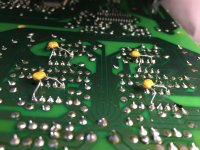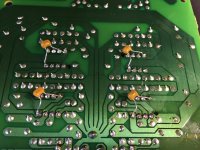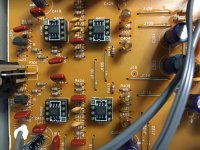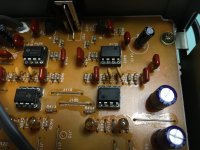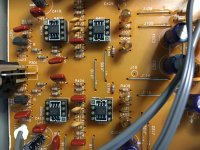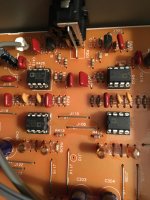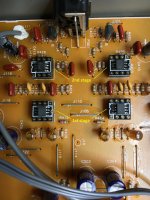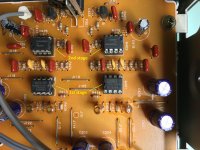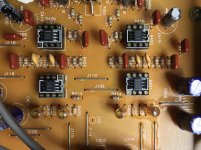Yes. Love the classic TDA1541. Even prefer it over the TDA1541A to be honest.
Coincidentally I just seen a video on YouTube that popped up about the Onkyo Intergrated tuner from my favourite tech I've seen, XrayTony. Such a nice and knowledgeable guy who's not arrogant and still willing to learn.
Random Video 4 - Shout Out Video & Test/Demo of Onkyo Tuner - YouTube
Coincidentally I just seen a video on YouTube that popped up about the Onkyo Intergrated tuner from my favourite tech I've seen, XrayTony. Such a nice and knowledgeable guy who's not arrogant and still willing to learn.
Random Video 4 - Shout Out Video & Test/Demo of Onkyo Tuner - YouTube
I know his channel. That's a TOTL earlier time T-9090 tuner he examines. Mine is known as T-4700 internationally. One model below the next gen TOTL T-9090 II. No coincidence he is rather impressed by that Onkyo's technical performance. Onkyo was producing top gun tuners back in the day.
You guys are right I have to say.
We cannot generalize opamps performance in different type of applications.
I should just have said that opa1656 was unbeatable in MY phono stages AND in MY own setup (turntable, cartridge, amplifier, speakers, cables...).
That was my initial intention and that's why I always want to post my system information before expressing opinion about sonic experiences of all kind of hifi stuff...
To this DX-710 player now...
I have installed the coupling capacitors underneath the main board (photos attached for any DIYers who might want to attempt similar mod in similar CD player.
So, as can be seen in the photos I had marked pins 1 of the opamps using a black marker when I first worked on the board.
With that someone can easily figure out which are the pins 4 and 8 on each opamp while working underside the board.
Pin 4 will always be the last pin on the side of pin 1 counting away from pin 1.
Pin 8 will always be the diagonally opposite side of pin 4 (speaking for DIP-8 package)
With that in mind I could not miss the correct locations.
So,
after that and after putting it all back together, I removed the NE5532s and threw in the AD8599s.
CD player took another jump to a higher level of sonic experience, this time the sound opened up a lot, I get even more details out of my speakers, I can now hear the timbre of the voices and the instruments.
I can now easily hear the decay of the notes as well, something i could not with the NE5532.
Highs seem to be right and pleasant, maybe a little bit recessed but i'm not sure until I listen to other opamps in this CDP.
Bass is equivalent to NE5532s, maybe slightly better defined.
The biggest jump of this change is the "attack" and the "airiness" of the sound i get from these AD8599s compared to the NE5532s. Better speed of transients too.
NJM4560s are already left far behind to all the above points...
What I'm not satisfied yet with (and I might be biased because I usually listen to my analog front end and not to CDs and I maybe compare with what i get from my vinyls),
is the depth of the sound-stage (which is excellent in my analog front end) and the bass definition and speed compared to what i get from my LP records.
(okay at this point: I play records with a Music Hall MMF-2.3SE, Ortofon Super OM40 cartridge, carefully adjusted and azimuth adjusted using Fozgometer, custom vinyl platter mat and Elliot's P06 phono preamp with opa1656 inside and again custom interconnects using mogami low capacitance cable and neutrik reann RCA connectors).
I will try AD823s, op2134 and the opa1656 in this cd player and report back overall results.
My amplifier, analog front end and speakers are all neutral sounding. That's something the readers should consider too while reading this.
At this point I'd say, even the NE5532 brings a whole new life to this cd player over the NJMs.
Stay tuned 🙂
We cannot generalize opamps performance in different type of applications.
I should just have said that opa1656 was unbeatable in MY phono stages AND in MY own setup (turntable, cartridge, amplifier, speakers, cables...).
That was my initial intention and that's why I always want to post my system information before expressing opinion about sonic experiences of all kind of hifi stuff...
To this DX-710 player now...
I have installed the coupling capacitors underneath the main board (photos attached for any DIYers who might want to attempt similar mod in similar CD player.
So, as can be seen in the photos I had marked pins 1 of the opamps using a black marker when I first worked on the board.
With that someone can easily figure out which are the pins 4 and 8 on each opamp while working underside the board.
Pin 4 will always be the last pin on the side of pin 1 counting away from pin 1.
Pin 8 will always be the diagonally opposite side of pin 4 (speaking for DIP-8 package)
With that in mind I could not miss the correct locations.
So,
after that and after putting it all back together, I removed the NE5532s and threw in the AD8599s.
CD player took another jump to a higher level of sonic experience, this time the sound opened up a lot, I get even more details out of my speakers, I can now hear the timbre of the voices and the instruments.
I can now easily hear the decay of the notes as well, something i could not with the NE5532.
Highs seem to be right and pleasant, maybe a little bit recessed but i'm not sure until I listen to other opamps in this CDP.
Bass is equivalent to NE5532s, maybe slightly better defined.
The biggest jump of this change is the "attack" and the "airiness" of the sound i get from these AD8599s compared to the NE5532s. Better speed of transients too.
NJM4560s are already left far behind to all the above points...
What I'm not satisfied yet with (and I might be biased because I usually listen to my analog front end and not to CDs and I maybe compare with what i get from my vinyls),
is the depth of the sound-stage (which is excellent in my analog front end) and the bass definition and speed compared to what i get from my LP records.
(okay at this point: I play records with a Music Hall MMF-2.3SE, Ortofon Super OM40 cartridge, carefully adjusted and azimuth adjusted using Fozgometer, custom vinyl platter mat and Elliot's P06 phono preamp with opa1656 inside and again custom interconnects using mogami low capacitance cable and neutrik reann RCA connectors).
I will try AD823s, op2134 and the opa1656 in this cd player and report back overall results.
My amplifier, analog front end and speakers are all neutral sounding. That's something the readers should consider too while reading this.
At this point I'd say, even the NE5532 brings a whole new life to this cd player over the NJMs.
Stay tuned 🙂
Attachments
What I'm not satisfied yet with ... is the depth of the sound-stage (which is excellent in my analog front end) and the bass definition and speed
Separating the power lines per channel (as I have recommended earlier) may help in this aspect.
Difference may be like this (another cd-player, not Onkyo):
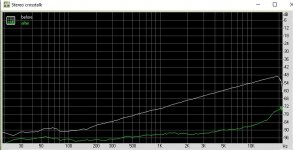
and it is definitely audible.
I was planning to listen to all of the rest of the op amps I have in mind and only then post an overall experience but...I wasn't expecting what i heard this evening...
AD8599 out -> AD823 in...
AD823 is PDIP-8 chip so no soldering and SOIC to DIP adapters needed. Just drop it in the DIP sockets and you're good to go...My eyes thank me for that 😀
I had experience with this chip from my phono preamp projects and although this chip had (and has) many virtues and great performance, there were a few issues that made me try other AD chips and the TI opa1656 which i finally settled with.
One was (not in real life auditions but in the specifications) the higher noise of 16 nV/√Hz @ 10 kHz the AD823 has while all my other chips were well below 8 nV. However, that never bothered me because the volume levels this was audible, it was simply so high a volume level that was unsustainable to my ears. I usually do not transform my house into a dance club 😱
The other issue was that with some recordings the AD823 sound was somewhat bright and tiresome to my ears at the point that after an hour or so I wouldn't want to listen anymore without a break...
For that reason, my expectations after throwing these chips into this Onkyo CD player were really low and I did it just from curiosity, thinking "if its sound was tiresome in a phono preamp go figure what's going to happen in a digital CD player source..."
Well, not.
Replacing AD8599s and hitting the "play" button on my CD, I got a very similar BIG and open sound, wide sound-stage and airiness.
However i got some more...
I finally got a somewhat deep sound-stage too (the AD823 3d presentation in my phono stages was unparalleled even compared to other AD chips like the AD8620). I'm not there where my analog front-end is from this perspective but i might never be with this CDP...
I wrote for the AD8599s i thought the highs seemed right but maybe a little bit "recessed" . I also wrote AD8599s low frequencies were similar to the NE5532 if a bit more well defined.
Well, both assumptions were correct as it seems.
AD823 compared to AD8599 brought a bit more details coming out from my speakers (especially at mid/high frequencies) but that's not all of it.
It brought a different level of realism to the percussion, cymbal hits particularly now sound like "cymbal hits" with a marvelous decay and not like just a metallic sound, high hats more accurate too.
Bass is for the first time very well defined, fast, with good transients and dynamics, deep and strong.
That's not something new, I got the same performance from the AD823 through my analog frontend too.
Playing Vanessa Williams' "what will i tell my heart" , the acoustic bass notes are simply on a different level than with the NE5532 and AD8599, deep, realistic, defined. The fast piano transients in the same song were handled by AD823 effortlessly and with great accuracy speed and timbre.
Same effortless presentation was evident with many other material when the number of the instruments was multiplying and the content was getting complex and a mix of the artist's voice and the so many instruments playing all at the same time.
That was also evident during my listening tests with my analog frontend and this chip inside.
What was totally unexpected is that his chip in the DC player is not harsh at all. I've been listening to it for 3 hours now non-stop and my ears do not complain at all.
To the noise issue, I don't know how that is possible but I cannot hear no noise at all, nada, zero.
I tried with tracks with quiet passages in it, and pumped up the volume, nothing...no noise. I cannot explain it.
What I might have lost in comparison to the AD8599 after this change?
I think AD8599 did slightly better with the voices, having a bit better timbre and detail to it.
Well, at this op amp performance level, there are always compromises to be done. There is no size fits all i guess...
there are a few more Texas Instruments chips to listen to the following days, will see how it goes...
Have a great weekend.
AD8599 out -> AD823 in...
AD823 is PDIP-8 chip so no soldering and SOIC to DIP adapters needed. Just drop it in the DIP sockets and you're good to go...My eyes thank me for that 😀
I had experience with this chip from my phono preamp projects and although this chip had (and has) many virtues and great performance, there were a few issues that made me try other AD chips and the TI opa1656 which i finally settled with.
One was (not in real life auditions but in the specifications) the higher noise of 16 nV/√Hz @ 10 kHz the AD823 has while all my other chips were well below 8 nV. However, that never bothered me because the volume levels this was audible, it was simply so high a volume level that was unsustainable to my ears. I usually do not transform my house into a dance club 😱
The other issue was that with some recordings the AD823 sound was somewhat bright and tiresome to my ears at the point that after an hour or so I wouldn't want to listen anymore without a break...
For that reason, my expectations after throwing these chips into this Onkyo CD player were really low and I did it just from curiosity, thinking "if its sound was tiresome in a phono preamp go figure what's going to happen in a digital CD player source..."
Well, not.
Replacing AD8599s and hitting the "play" button on my CD, I got a very similar BIG and open sound, wide sound-stage and airiness.
However i got some more...
I finally got a somewhat deep sound-stage too (the AD823 3d presentation in my phono stages was unparalleled even compared to other AD chips like the AD8620). I'm not there where my analog front-end is from this perspective but i might never be with this CDP...
I wrote for the AD8599s i thought the highs seemed right but maybe a little bit "recessed" . I also wrote AD8599s low frequencies were similar to the NE5532 if a bit more well defined.
Well, both assumptions were correct as it seems.
AD823 compared to AD8599 brought a bit more details coming out from my speakers (especially at mid/high frequencies) but that's not all of it.
It brought a different level of realism to the percussion, cymbal hits particularly now sound like "cymbal hits" with a marvelous decay and not like just a metallic sound, high hats more accurate too.
Bass is for the first time very well defined, fast, with good transients and dynamics, deep and strong.
That's not something new, I got the same performance from the AD823 through my analog frontend too.
Playing Vanessa Williams' "what will i tell my heart" , the acoustic bass notes are simply on a different level than with the NE5532 and AD8599, deep, realistic, defined. The fast piano transients in the same song were handled by AD823 effortlessly and with great accuracy speed and timbre.
Same effortless presentation was evident with many other material when the number of the instruments was multiplying and the content was getting complex and a mix of the artist's voice and the so many instruments playing all at the same time.
That was also evident during my listening tests with my analog frontend and this chip inside.
What was totally unexpected is that his chip in the DC player is not harsh at all. I've been listening to it for 3 hours now non-stop and my ears do not complain at all.
To the noise issue, I don't know how that is possible but I cannot hear no noise at all, nada, zero.
I tried with tracks with quiet passages in it, and pumped up the volume, nothing...no noise. I cannot explain it.
What I might have lost in comparison to the AD8599 after this change?
I think AD8599 did slightly better with the voices, having a bit better timbre and detail to it.
Well, at this op amp performance level, there are always compromises to be done. There is no size fits all i guess...
there are a few more Texas Instruments chips to listen to the following days, will see how it goes...
Have a great weekend.
Attachments
When you get to this point in swapping and testing and listening, and particularly when using high performance devices then I think the next step has to be to dangle a scope on the output and check that nothing is going amiss.
Have a look at where this came from:
Swapping Op-Amps... you have checked to see it's stable haven't you ?
Have a look at where this came from:
Swapping Op-Amps... you have checked to see it's stable haven't you ?
Would you know it was unstable by listening ? Well actually, you may not, and may put the change in sound down to the op-amp ! The AD797 certainly sounded over bright and thin but I can imagine some saying, "hey listen to that extra detail" it just shows how murky and dull the 5534 was. A bit extreme maybe, but you see my point.
The OPA604... far more subtle and many wouldn't notice the problem in a lot of systems.
So I hope that helps explain the "always check for stabilty etc" that I always trot out, and some of you reading this are probably doing so because I just linked your thread on "what should I replace xxxxxx with" to this one 😉
Happy swapping...
When you get to this point in swapping and testing and listening, and particularly when using high performance devices then I think the next step has to be to dangle a scope on the output and check that nothing is going amiss.
Have a look at where this came from:
Swapping Op-Amps... you have checked to see it's stable haven't you ?
Will definitely do that as I have just ordered a PC oscilloscope to try check and adjust a cassette deck heads I've acquired recently (nostalgia).
And I would probably ask you guys for advice with using it but I need to do my homework first...to read the basics at the very least...
Well I'm done with all of my tests with swapping Op Amps into this Onkyo DX-710 cd player, and, this is what think..
No "scientific" basis behind those tests as I've just listened to those Op Amps, not measured them...
This is the full list of the Op Amps tried:
1. NE5532, price at Mouser $0.57 each, package DIP-8
2. AD8599, price at Mouser $8.18 each, package SOIC-8
3. AD823, price at Mouser $9.58 each, package DIP-8
4. OPA1656, price at Mouser $2.73 each, package SOIC-8
5. AD8620, price at Mouser $16.27 each, package SOIC-8
6. ADA4625-2, price at Mouser $10.56 each, package SOIC-8
7. OPA2134, price at Mouser $4.80 each, package DIP-8
8. LM4562, price at Mouser $1.65 each, package DIP-8
9. OPA1642, price at Mouser $2.51 each, package SOIC-8
All SOIC-8 chips can be used if mounted on SOIC8-to-DIP browndog adapters which I usually buy for $3 - $2.50 each with pins installed (depends on the quantity I buy - if more than 5 then the price is $2.50 each).
So here it goes:
(i have also attached photos of all these chips, the very left should be the NE5532 and counting from there...)
1. NE5532
Commented at post #32 for this one, clearly better sounding than the stock NJM4560s. The least upgrade I could do for this CD player. Bass is not clean, sounds muddy and slow but a good amount of it is offered. Better stereo separation and more details than the NJM, more "musical" than the NJM and partially solved the initial "female voices harshness issue I had by reducing it a lot.
2. AD8599
Reviewed at post #63, a clear improvement over NE5532 bringing BIG sound to the picture with much more details, better wider sound-stage, better stereo separation, better highs, better job with voices (tamed female voices completely) and bass very similar to NE5532, which for me is not on par with other Analog Devices chips in regards to definition and speed.
3. AD823
This chip reviewed at post #66 but,
this chip performance proves to be rather controversial IMHO, reason being that after listening to more Analog Devices chips in this CDP i have discovered brightness and slight harshness compared to those, although the chip did very well in here compared to my analog front-end.
Big and open sound, sound-stage started for the first time to get some depth, excellent bass definition where I can hear when one note ends and the next starts.
Realistic cymbals and nice highs but the female voices and the voices in general could do better (as we will see later on). It's a strong player though. Airiness is very good.
4. OPA1656
Well, this chip amazes me in this CDP as it did in my analog front-end. BIG, OPEN, BOLD sound are immediately evident after pressing the play button.
There are not many things i could find wrong with this chip. Excellent detail retrieval, very good bass, fast deep and full (slightly not so well defined compared to AD chips), amazing mid-range, excellent job with voices, wide sound-stage (though not so deep), excellent stereo separation and airiness.
There was almost nothing this chip was not doing well in this CDP.
5. AD8620 in 1st stage and ADA4625-2 in 2nd stage
I didn't have 4 of each of these chips but i wanted to listen to it anyways so I used them in pairs in each stage.
These chips did a great job and are clearly above all other Analog Devices chips i tried in this CDP. They are clearly above all Texas Instruments chips except the OPA1656 where they found their strong competitor.
How did they sound?
Very open, and big sound, excellent sound-stage both wide but also deep for the very first time in this listening test.
Highs are detailed and much more polite, sweet and musical than AD823, excellent mid-range, excellent voices rivaled only by the OPA1656, totally tamed the female voices as OPA1656 did too.
However, the bass here is clearly better defined than OPA1656, is clean, fast, accurate, deep enough and with very good body.
Not sure which of the 2 sets of these chips does most of the work, but could very well be the AD8620s which are in the 1st stage.
The AD8620s also happen to be the most expensive chip of all in the test.
ADA4625-2 is the second most expensive and is the JFET chip with the lowest noise of all AD JFET chips, it is also the second newest (2017) while OPA1656 is the newest of all (2019).
This combination really was the only chips which presented a really deep 3D sound-stage in this CDP. Not up to my analog front end but the best in this test.
6. OPA2134 in 1st stage LM4562 in 2nd stage.
Again, not having 4 of each, I used these chips in pairs.
This combination sounded really nice, much much better than the NE5532 with greater sound-stage width, better stereo separation, better detail retrieval, better bass which was also better defined and faster than the NE5532, overall musicality was a very pleasing listen.
However, this combination could not surpass the OPA1656s or the AD8620/ADA4625-2 combo by any means.
I'd say it cannot surpass even the AD823s in many aspects, however AD823 is a "difficult" chip for me to digest in general because of the presence of other rivals in this test.
I would place this 2134/4562 somewhere between NE5532 and AD8599. For sure someone can't go wrong with these chips in this CDP though.
7. OPA1642
Well, this chip is marketed by TI as "JFET-input, High Performance, Audio Operational Amplifier".
I have bought these chips some time ago out of curiosity and after i read some good reviews for it around the net. First time they played in my phono preamp.
In this CD player, it sounded very good but I'm not quite sure why someone would choose this chip over OPA1656, given that they cost about the same but OPA1656 performance is above OPA1642 as I have confirmed both in my analog stage but also in this cd player.
It does everything very well and I would rate this chip slightly above the opa2134/LM4562 combo.
In this cd player it didn't match AD8620/ADA4625-2 combo performance and it didn't much opa1656 performance either. But it definitely gave me very good sound.
Overall
If I was to put all the above in groups by their performance in this Cd player, I would put it like below:
Group A (best performance)
OPA1656, AD8620/ADA4625-2
Group B (second best performance)
OPA1642, AD823 (?)
Group C (very good performance)
AD8599, OPA2134/LM4562
Group D (good performance)
NE5532
Group E (poor compared to newer designs)
NJM4560DX
My final conclusion
There was very strong competition between the opa1656 and the AD8620/ADA4625-2 combo.
It is not a clear cut for the reason that all of those chips gave the most balanced, big, open, airy, detailed performance and all of them were clearly above all the others in this CD player.
Strong points of the Analog Devices chips were: the impressive clean and fast bass response, the decay of the notes which were clearly audible, the 3D sound-stage, bettering opa1656 sound-stage.
Strong points of the opa1656 chip were: better timbre of both voices and instruments, bold sound (which is really impressive). While opa1656 does not fall far behind the AD combo with the bass response, is slightly "dirtier"..
All other being equal I had to choose one over the other.
I will settle with the AD combo for now without excluding the possibility of switching to opa1656 sometime in the future.
You see timbre is a very important aspect towards sonic realism. That's what we're all after at the end of the day, right?
Thank you all for your help in making this project become reality with no "electronic components" casualties 🙂
No "scientific" basis behind those tests as I've just listened to those Op Amps, not measured them...
This is the full list of the Op Amps tried:
1. NE5532, price at Mouser $0.57 each, package DIP-8
2. AD8599, price at Mouser $8.18 each, package SOIC-8
3. AD823, price at Mouser $9.58 each, package DIP-8
4. OPA1656, price at Mouser $2.73 each, package SOIC-8
5. AD8620, price at Mouser $16.27 each, package SOIC-8
6. ADA4625-2, price at Mouser $10.56 each, package SOIC-8
7. OPA2134, price at Mouser $4.80 each, package DIP-8
8. LM4562, price at Mouser $1.65 each, package DIP-8
9. OPA1642, price at Mouser $2.51 each, package SOIC-8
All SOIC-8 chips can be used if mounted on SOIC8-to-DIP browndog adapters which I usually buy for $3 - $2.50 each with pins installed (depends on the quantity I buy - if more than 5 then the price is $2.50 each).
So here it goes:
(i have also attached photos of all these chips, the very left should be the NE5532 and counting from there...)
1. NE5532
Commented at post #32 for this one, clearly better sounding than the stock NJM4560s. The least upgrade I could do for this CD player. Bass is not clean, sounds muddy and slow but a good amount of it is offered. Better stereo separation and more details than the NJM, more "musical" than the NJM and partially solved the initial "female voices harshness issue I had by reducing it a lot.
2. AD8599
Reviewed at post #63, a clear improvement over NE5532 bringing BIG sound to the picture with much more details, better wider sound-stage, better stereo separation, better highs, better job with voices (tamed female voices completely) and bass very similar to NE5532, which for me is not on par with other Analog Devices chips in regards to definition and speed.
3. AD823
This chip reviewed at post #66 but,
this chip performance proves to be rather controversial IMHO, reason being that after listening to more Analog Devices chips in this CDP i have discovered brightness and slight harshness compared to those, although the chip did very well in here compared to my analog front-end.
Big and open sound, sound-stage started for the first time to get some depth, excellent bass definition where I can hear when one note ends and the next starts.
Realistic cymbals and nice highs but the female voices and the voices in general could do better (as we will see later on). It's a strong player though. Airiness is very good.
4. OPA1656
Well, this chip amazes me in this CDP as it did in my analog front-end. BIG, OPEN, BOLD sound are immediately evident after pressing the play button.
There are not many things i could find wrong with this chip. Excellent detail retrieval, very good bass, fast deep and full (slightly not so well defined compared to AD chips), amazing mid-range, excellent job with voices, wide sound-stage (though not so deep), excellent stereo separation and airiness.
There was almost nothing this chip was not doing well in this CDP.
5. AD8620 in 1st stage and ADA4625-2 in 2nd stage
I didn't have 4 of each of these chips but i wanted to listen to it anyways so I used them in pairs in each stage.
These chips did a great job and are clearly above all other Analog Devices chips i tried in this CDP. They are clearly above all Texas Instruments chips except the OPA1656 where they found their strong competitor.
How did they sound?
Very open, and big sound, excellent sound-stage both wide but also deep for the very first time in this listening test.
Highs are detailed and much more polite, sweet and musical than AD823, excellent mid-range, excellent voices rivaled only by the OPA1656, totally tamed the female voices as OPA1656 did too.
However, the bass here is clearly better defined than OPA1656, is clean, fast, accurate, deep enough and with very good body.
Not sure which of the 2 sets of these chips does most of the work, but could very well be the AD8620s which are in the 1st stage.
The AD8620s also happen to be the most expensive chip of all in the test.
ADA4625-2 is the second most expensive and is the JFET chip with the lowest noise of all AD JFET chips, it is also the second newest (2017) while OPA1656 is the newest of all (2019).
This combination really was the only chips which presented a really deep 3D sound-stage in this CDP. Not up to my analog front end but the best in this test.
6. OPA2134 in 1st stage LM4562 in 2nd stage.
Again, not having 4 of each, I used these chips in pairs.
This combination sounded really nice, much much better than the NE5532 with greater sound-stage width, better stereo separation, better detail retrieval, better bass which was also better defined and faster than the NE5532, overall musicality was a very pleasing listen.
However, this combination could not surpass the OPA1656s or the AD8620/ADA4625-2 combo by any means.
I'd say it cannot surpass even the AD823s in many aspects, however AD823 is a "difficult" chip for me to digest in general because of the presence of other rivals in this test.
I would place this 2134/4562 somewhere between NE5532 and AD8599. For sure someone can't go wrong with these chips in this CDP though.
7. OPA1642
Well, this chip is marketed by TI as "JFET-input, High Performance, Audio Operational Amplifier".
I have bought these chips some time ago out of curiosity and after i read some good reviews for it around the net. First time they played in my phono preamp.
In this CD player, it sounded very good but I'm not quite sure why someone would choose this chip over OPA1656, given that they cost about the same but OPA1656 performance is above OPA1642 as I have confirmed both in my analog stage but also in this cd player.
It does everything very well and I would rate this chip slightly above the opa2134/LM4562 combo.
In this cd player it didn't match AD8620/ADA4625-2 combo performance and it didn't much opa1656 performance either. But it definitely gave me very good sound.
Overall
If I was to put all the above in groups by their performance in this Cd player, I would put it like below:
Group A (best performance)
OPA1656, AD8620/ADA4625-2
Group B (second best performance)
OPA1642, AD823 (?)
Group C (very good performance)
AD8599, OPA2134/LM4562
Group D (good performance)
NE5532
Group E (poor compared to newer designs)
NJM4560DX
My final conclusion
There was very strong competition between the opa1656 and the AD8620/ADA4625-2 combo.
It is not a clear cut for the reason that all of those chips gave the most balanced, big, open, airy, detailed performance and all of them were clearly above all the others in this CD player.
Strong points of the Analog Devices chips were: the impressive clean and fast bass response, the decay of the notes which were clearly audible, the 3D sound-stage, bettering opa1656 sound-stage.
Strong points of the opa1656 chip were: better timbre of both voices and instruments, bold sound (which is really impressive). While opa1656 does not fall far behind the AD combo with the bass response, is slightly "dirtier"..
All other being equal I had to choose one over the other.
I will settle with the AD combo for now without excluding the possibility of switching to opa1656 sometime in the future.
You see timbre is a very important aspect towards sonic realism. That's what we're all after at the end of the day, right?
Thank you all for your help in making this project become reality with no "electronic components" casualties 🙂
Attachments
Thanks for detailing all of that 🙂
When you look at your own preference it appears that the FET based opamps come out in front and that may well add weight to the argument that BJT based devices (like the NE5532 and NJM's) perform less well in applications such as these where there can be HF artefacts present. There is a line of thinking that suggests these can cause unwanted distortions and non linearities, something the FET based input stages are more immune from.
A PC based scope should be OK for basic analogue work and looking at and adjusting levels and so on but may be out of its depth looking for high frequency oscillation and so on as these kind of signals run into the 10's of Megahertz region.
When you look at your own preference it appears that the FET based opamps come out in front and that may well add weight to the argument that BJT based devices (like the NE5532 and NJM's) perform less well in applications such as these where there can be HF artefacts present. There is a line of thinking that suggests these can cause unwanted distortions and non linearities, something the FET based input stages are more immune from.
A PC based scope should be OK for basic analogue work and looking at and adjusting levels and so on but may be out of its depth looking for high frequency oscillation and so on as these kind of signals run into the 10's of Megahertz region.
Thanks for detailing all of that 🙂
When you look at your own preference it appears that the FET based opamps come out in front and that may well add weight to the argument that BJT based devices (like the NE5532 and NJM's) perform less well in applications such as these where there can be HF artefacts present. There is a line of thinking that suggests these can cause unwanted distortions and non linearities, something the FET based input stages are more immune from.
It looks like so.. 🙂
A PC based scope should be OK for basic analogue work and looking at and adjusting levels and so on but may be out of its depth looking for high frequency oscillation and so on as these kind of signals run into the 10's of Megahertz region.
I'm afraid I will never be able to measure HF oscillation then 🙂 Multi-MHz scopes are expensive and really beyond my budget (and beyond my expertise too), I will leave that job to the pros instead 😀
Did you need another one?
https://sfbay.craigslist.org/eby/ele/d/vintage-onkyo-cd-player/7822782796.html
https://sfbay.craigslist.org/eby/ele/d/vintage-onkyo-cd-player/7822782796.html
- Home
- Source & Line
- Digital Source
- Onkyo DX710 Op Amp mods asking advice
